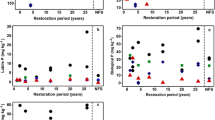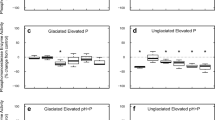Abstract
Although low solubility and slow cycling control P circulation in a wide range of ecosystems, most studies that evaluate bioavailability of soil P use only indices of short-term supply. The objective here is to quantify changes in P fractions in an Ultisol during the growth of an old-field pine forest from 1957 to 2005, specifically changes with organic P (Po) and with inorganic P (Pi) associated with Fe and Al oxides as well as Ca compounds. Changes in soil P were estimated from archived mineral soil samples collected in 1962 shortly after pine seedlings were planted, and on six subsequent occasions (1968, 1977, 1982, 1990, 1997, and 2005) from eight permanent plots and four mineral soil layers (0–7.5, 7.5–15, 15–35, and 35–60 cm). Despite the net transfer of 82.5 kg ha−1 of P from mineral soil into tree biomass and O horizons, labile soil P was not diminished, as indexed by anion exchange resins, and NaHCO3 and Mehlich III extractants. An absence of depletion in most labile P fractions masks major restructuring of soil P chemistry driven by ecosystem development. During 28 years of forest growth, decreases were significant and substantial in slowly cycling Po and Pi associated with Fe and Al oxides and Ca compounds, and these accounted for most of the P supplied to biomass and O horizons, and for buffering labile soil fractions as well. Changes in soil P are attributed to the P sink strength of the aggrading forest (at 2.9 kg ha−1 year−1 over 28 years); legacies of fertilization, which enriched slowly cycling fractions of Po and Pi; and the changing biogeochemistry of the soil itself.




Similar content being viewed by others
References
Baldwin VC (1987) Green and dry-weight equations for above-ground components of planted loblolly pine trees in the West Gulf region. South J Appl For 11:212–218
Barber SA (1979) Soil phosphorus after 25 years of cropping with five rates of phosphorus application. Commun Soil Sci Plant Anal 10:1459–1468
Beck MA, Sánchez PA (1994) Soil phosphorus fraction dynamics during 18 years of cultivation on a typic paleudult. Soil Sci Soc Am J 58:1424–1431
Billings S, Richter DD (2006) Changes in stable isotopic signatures of soil nitrogen and carbon during forty years of forest development. Oecologia 148:325–333
Bray RH, Kurtz LT (1945) Determination of total, organic, and available forms of phosphorus in soils. Soil Sci 59:39–45
Buol SA (1995) Sustainability of soil use. Annu Rev Ecol Syst 26:25–44
Buol SA, Southard RJ, Graham RC, McDaniel PA (2003) Soil genesis and classification. Blackwell, Oxford, UK
Carter MR (1993) Soil sampling and methods of analysis. Canadian Society of Soil Science, Lewis Publ., Boca Raton, FL
Chadwick OA, Derry LA, Vitousek PM, Huebert BJ, Hedin LO (1999) Changing sources of nutrients during four million years of ecosystem development. Nature 397:491–497
Chang SC, Jackson ML (1957) Fractionation of soil phosphorus. Soil Sci 84:133–144
Cope JT (1981) Effects of 50 years of fertilization with phosphorus and potassium on soil test levels and yields at six locations. Soil Sci Soc Am J 45:342–347
Cox FR, Kamprath EJ, McCollum RE (1981) A descriptive model of soil test nutrient levels following fertilization. Soil Sci Soc Am J 45:529–532
Crews TE, Kitayama K, Fownes JH, Riley RH, Herbert DA, Mueller-Dombois D, Vitousek PM (1995) Changes in soil phosphorus fractions and ecosystem dynamics across a long chronosequence in Hawaii. Ecology 76:1407–1424
Cross AF, Schlesinger WH (1994) A literature review and evaluation of the Hedley fractionation: applications to the biogeochemical cycle of soil phosphorus in natural ecosystems. Geoderma 64:197–214
Dalal RC (1977) Soil organic phosphorus. Adv Agron 29:83–113
EPA (1971) Methods of chemical analysis for water and wastes. US Environmental Protection Agency, Cincinnati, OH
Fox RL, Kamprath EJ (1970) Phosphorus sorption isotherms for evaluating the phosphate requirements of soils. Soil Sci Soc Am Proc 34:902–907
Frizano J, Johnson AH, Vann DR, Scatena FN (2002) Soil phosphorus fractionation during forest development on landslide scars in the Luquillo Mountains, Puerto Rico. Biotropica 34:17–26
Garcia-Montiel DC, Neill C, Melillo J, Thomas S, Steudler PA, Cerri CC (2000) Soil phosphorus transformations following forest clearing for pasture in the Brazilian Amazon. Soil Sci Soc Am J 64:1792–1804
Gnau CB (1992) Modeling the hydrologic cycle during 25 years of forest development. Masters Project, School of the Environment, Duke University, Durham, NC
Goh KM, Condron LM (1989) Plant availability of phosphorus accumulated from long-term applications of superphosphate and effluent to irrigated pastures. NZ J Agric Res 32:45–51
Gray LC (1933) History of agriculture in the Southern United States to 1860. The Carnegie Institution of Washington, Washington, DC
Hamon RE, Bertrand I, McLaughlin MJ (2002) Use and abuse of isotopic exchange data in soil chemistry. Aust J Soil Res 40:1371–1381
Hedley MJ, Stewart JWB, Chauhan BS (1982a) Changes in the inorganic and organic soil phosphorus fractions induced by cultivation practices and by laboratory incubations. Soil Sci Soc Am J 46:970–976
Hedley MJ, White RE, Nye RH (1982b) Plant-induced changes in the rhizosphere of rape (Brassica napus var. Emerald) seedlings. III. Changes in L value, soil phosphate fractions, and phosphatase activity. New Phytol 91:45–56
Hilgard EW (1860) Report on the geology and agriculture of the state of Mississippi. State Government of Mississippi, Jackson, MS
Hilgard EW (1906) Soils. Macmillan, New York
Hu HQ, He JZ, Li XY, Liu F (2001) Effect of several organic acids on phosphate adsorption by variable charge soils of central China. Environ Int 26:353–358
Johnson DW, Lindberg SE (1992) Atmospheric deposition and nutrient cycling in forest ecosystems. Springer Berlin Heidelberg, New york.
Kapeluck PR, Van Lear DH (1995) A technique for estimating below-stump biomass of mature loblolly pine plantations. Can J For Res 25:355–360
Karpinets TV, Greenwood DJ, Ammons JT (2004) Predictive mechanistic model of soil phosphorus dynamics with readily available inputs. Soil Sci Soc Am J 68:644–653
Markewitz D, Richter DD, Allen HL, Urrego JB (1998) Three decades of observed soil acidification at the Calhoun Experimental Forest: has acid rain made a difference? Soil Sci Soc Am J 62:1428–1439
McCollum RE (1991) Buildup and decline of soil phosphorus: 30 year trends on a Typic Umbraquult. Agron J 83:77–85
McDowell R, Sinaj S, Sharpley A, Frossard E (2001) The use of isotopic exchange kinetics to assess phosphorus availability in overland flow and subsurface drainage waters. Soil Sci 166:365–373
Mehlich A (1978) New extractant for soil test evaluation of phosphorus, potassium, magnesium, calcium, sodium, manganese, and zinc. Commun Soil Sci Plant Anal 9:477–492
Mitchell CC, Arriaga FJ, Entry JA, Novak JL, Goodman WR, Reeves DW, Runge MW, Traxler GJ (1996) The old rotation. Auburn University Agricultural Experiment Station, Auburn, AL
Murphy J, Riley JP (1962) A modified single solution method for the determination of phosphate in natural waters. Anal Chim Acta 27:31–36
Nelson LE, Switzer GL (1975) Estimating weights of loblolly pine trees and their components in natural stands and plantations in central Mississippi. Technical Bulletin 73, Mississippi Agricultural and Forestry Experiment Station, MS
Novais R, Kamprath EJ (1978) Phosphorus supplying capacities of previously heavily fertilized soils. Soil Sci Soc Am J 42:931–935
Novak JM, Watts DW (2004) Increasing the phosphorus sorption capacity of Southeastern Coastal Plain soils using water treatment residuals. Soil Sci 169:206–214
Olsen SR, Cole CV, Watanabe FS, Dean LA (1954) Estimation of available phosphorus in soils by extraction with sodium bicarbonate. United States Department of Agriculture Circular 939. United States Government Printing Office, Washington, DC
Page AL (1982) Methods of soil analysis; chemical and microbiological properties, part 2. Soil Science Society of America, Madison, WI
Parfitt RL (1978) Anion adsorption by soils and soil materials. Adv Agron 30:1–50
Pehl CE, Tuttle CL, Houser JN, Moehring DM (1984) Total biomass and nutrients of 25-year-old loblolly pines (Pinus taeda L.). For Ecol Manage 9:155–160
Richter DD, Babbar LI (1991) Soil diversity in the tropics. Adv Ecol Res 21:316–389
Richter DD, Markewitz D (1995) How deep is soil? Bioscience 45:600–609
Richter DD, Markewitz D (2001) Understanding soil change. Cambridge University Press, Cambridge
Richter DD, Markewitz D, Wells CG, Allen HL, April RH, Heine PR, Urrego B (1994) Soil chemical change during three decades in an old-field loblolly pine (Pinus taeda L.) ecosystem. Ecology 75:1463–1473
Richter DD, Markewitz D, Trumbore SA, Wells CG (1999) Rapid accumulation and turnover of soil carbon in a re-establishing forest. Nature 400:56–58
Richter DD, Markewitz D, Heine PR, Jin V, Raikes J, Tian K, Wells CG (2000) Legacies of agriculture and forest regrowth in the nitrogen of old-field soils. Forest Ecol Manag 138:233–248
Ruffin E (1852) An essay on calcareous manures. JW Randolph, Richmond, VA
Schmidt JP, Buol SW, Kamprath EJ (1996) Soil phosphorus dynamics during seventeen years of continuous cultivation: fractionation analyses. Soil Sci Soc Am J 60:1168–1172
Schmidt JP, Buol SW, Kamprath EJ (1997) Soil phosphorus dynamics during 17 years of continuous cultivation: a method to estimate long-term P availability. Geoderma 78:59–70
Shelton JE, Coleman NT (1968) Inorganic phosphorus fractions and their relationship to residual value of large applications of phosphorus on high phosphorus fixing soils. Soil Sci Soc Am Proc 32:91–94
Shelton MG, Nelson LE, Switzer GL (1984) The weight, volume and nutrient status of plantation-grown loblolly pine trees in the interior flatwoods of Mississippi. Technical Bulletin 121, Mississippi Agricultural and Forestry Experiment Station, MS
Sheridan RC (1979) Chemical fertilizers in southern agriculture. Agric Hist 53:308–318
Soil Survey Staff (2003) Keys to soil taxonomy. Cornell University, Ithaca, NY
Soloman D, Lehmann J, Mamo T, Fritzsche F, Zech W (2002) Phosphorus forms and dynamics as influenced by land use changes in the sub-humid Ethiopian highlands. Geoderma 105:21–48
Switzer GL, Nelson LE (1972) Nutrient accumulation and cycling in loblolly pine (Pinus taeda L.) plantation ecosystems: the first twenty years. Soil Sci Soc Am J 36:143–147
Thomas GW, Peaslee DE (1973) Testing soils for phosphorus. In: Walsh LM, Beaton JD (eds) Soil testing and plant analysis. Soil Science Society of America, Madison, WI, pp 115–132
Tiessen H, Moir JO (1993) Characterization of available P by sequential extraction. In: Carter MR (ed) Soil sampling and analysis. Canadian Society of Soil Science, Lewis Publ., New York, pp 75–86
Tiessen H, Salceda IH, Sampaio EVSB (1992) Nutrient and soil organic matter dynamics under shifting cultivation in semi-arid northeastern Brazil. Agric Ecosyst Environ 38:139–151
Townsend AR, Asner GP, Cleveland CC, Lefer ME, Bustamante MMC (2002) Unexpected changes in soil phosphorus dynamics along pasture chronosequences in the humid tropics. J Geophys Res 107(D20):8067–8076
Urrego MJB (1993) Nutrient accumulation in biomass and forest floor of a 34-year-old loblolly pine plantation. MS thesis, North Carolina State University, Raleigh, NC
Vance RB (1929) Human factors in cotton culture. University of North Carolina, Chapel Hill, NC
Van Lear DH, Kapeluck PR (1995) Above- and below-stump biomass and nutrient content of a mature loblolly pine plantation. Can J For Res 25:361–367
Van Lear DH, Waide JB, Teuke MJ (1984) Biomass and nutrient content of a 41-year-old loblolly pine (Pinus teada L.) plantation on a poor site in South Carolina. For Sci 30:395–404
Walker TW, Syers JK (1976) The fate of phosphorus during pedogenesis. Geoderma 15:1–19
Author information
Authors and Affiliations
Corresponding author
Additional information
Communicated by Tim Seastedt
Rights and permissions
About this article
Cite this article
Richter, D.D., Allen, H.L., Li, J. et al. Bioavailability of slowly cycling soil phosphorus: major restructuring of soil P fractions over four decades in an aggrading forest. Oecologia 150, 259–271 (2006). https://doi.org/10.1007/s00442-006-0510-4
Received:
Accepted:
Published:
Issue Date:
DOI: https://doi.org/10.1007/s00442-006-0510-4




